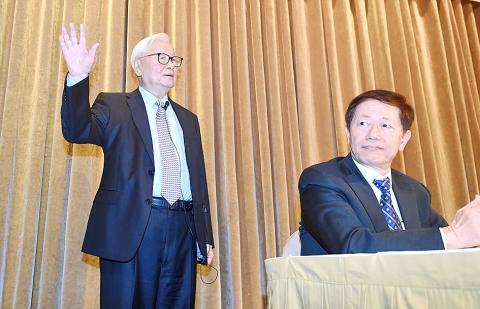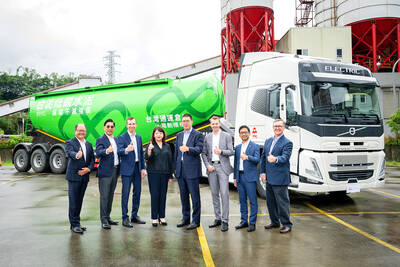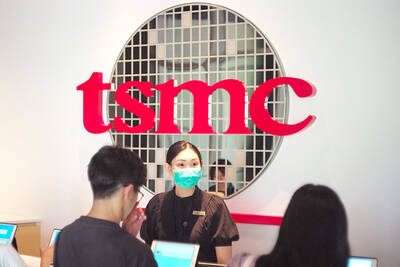Taiwan Semiconductor Manufacturing Co (TSMC, 台積電), the world’s largest contract chipmaker, yesterday posted a record-breaking net profit of NT$343.11 billion (US$11.61 billion) for last year, benefiting from robust chip demand for smartphones and cryptocurrency mining machines.
That represented an annual growth of 2.65 percent from NT$334.25 billion in 2016, according to the chipmaker’s financial statement. Earnings per share rose to NT$13.23 from NT$12.89.
While the pace of growth decelerated from 2016’s 10 percent increase, the chipmaker expects the growth momentum to carry on this year.

Photo: Liao Chen-huei, Taipei Times
This year will be “an above-average year,” TSMC founder and chairman Morris Chang (張忠謀) told investors at his last appearance at the company’s quarterly earnings conference.
Chang is set to retire this summer.
Revenue growth would accelerate to between 10 and 15 percent this year in US dollar terms, following a 9 percent increase last year, Chang said.
That would be faster than the company’s five-year target of compound annual growth of between 5 and 10 percent from last year to 2021.
Chang said he expects growth to be fueled by three of the firm’s growth platforms: high-performance computing (HPC), Internet of Things and automotive.
Replacing mobile phone chips, “HPC chips will grow the strongest due to continuing expansion of AI [artificial intelligence] applications in all electronic devices, as well as continuing demand for cryptocurrency GPU [graphics processor unit] and etc,” Chang said in English.
“The urge to mine cryptocurrency is very strong. The [cryptocurrency] price is very volatile, but the demand since the last year has been very strong. We expect it will continue to be strong,” he said.
“However, we will size the demand carefully,” he added.
Mobile phone chips, the biggest revenue contributor to TSMC, would see little growth this year, he predicted.
Based on Chang’s growth projection, TSMC would again outperform the global semiconductor industry’s projected annual growth of between 6 and 8 percent, and the foundry sector’s annual growth of between 9 and 10 percent this year.
However, due to the smartphone industry’s slow-season effect, TSMC expects revenue to shrink by 8.3 percent sequentially this quarter to between US$8.4 billion and US$8.5 billion.
Gross margin is expected to reach between 49.5 percent and 51 percent this quarter, compared with 50 percent last quarter, TSMC said.
The company’s net profit dropped 0.9 percent to NT$99.29 billion in the final quarter of last year, compared with a record-high NT$100.2 billion in the fourth quarter of 2016.
The company attributed the contraction to a 1.5 percent appreciation of the New Taiwan dollar against the US dollar.
On a quarterly basis, net profit increased 10.4 percent from NT$89.93 billion, the company’s financial statement showed.
To support the company’s growth and customer demand, TSMC plans to spend between US$10.5 billion and US$11 billion this year, mainly on new equipment for 7-nanometer manufacturing and developing 5-nanometer technology.
TSMC is on track to start mass production of its 7-nanometer chips — mostly for smartphones and AI applications — next quarter, TSMC cochief executive C.C. Wei (魏哲家) told the conference.
The 7-nanometer chips are to account for 10 percent of the company’s total revenue this year, Wei said.

Taiwan Transport and Storage Corp (TTS, 台灣通運倉儲) yesterday unveiled its first electric tractor unit — manufactured by Volvo Trucks — in a ceremony in Taipei, and said the unit would soon be used to transport cement produced by Taiwan Cement Corp (TCC, 台灣水泥). Both TTS and TCC belong to TCC International Holdings Ltd (台泥國際集團). With the electric tractor unit, the Taipei-based cement firm would become the first in Taiwan to use electric vehicles to transport construction materials. TTS chairman Koo Kung-yi (辜公怡), Volvo Trucks vice president of sales and marketing Johan Selven, TCC president Roman Cheng (程耀輝) and Taikoo Motors Group

Among the rows of vibrators, rubber torsos and leather harnesses at a Chinese sex toys exhibition in Shanghai this weekend, the beginnings of an artificial intelligence (AI)-driven shift in the industry quietly pulsed. China manufactures about 70 percent of the world’s sex toys, most of it the “hardware” on display at the fair — whether that be technicolor tentacled dildos or hyper-realistic personalized silicone dolls. Yet smart toys have been rising in popularity for some time. Many major European and US brands already offer tech-enhanced products that can enable long-distance love, monitor well-being and even bring people one step closer to

RECORD-BREAKING: TSMC’s net profit last quarter beat market expectations by expanding 8.9% and it was the best first-quarter profit in the chipmaker’s history Taiwan Semiconductor Manufacturing Co (TSMC, 台積電), which counts Nvidia Corp as a key customer, yesterday said that artificial intelligence (AI) server chip revenue is set to more than double this year from last year amid rising demand. The chipmaker expects the growth momentum to continue in the next five years with an annual compound growth rate of 50 percent, TSMC chief executive officer C.C. Wei (魏哲家) told investors yesterday. By 2028, AI chips’ contribution to revenue would climb to about 20 percent from a percentage in the low teens, Wei said. “Almost all the AI innovators are working with TSMC to address the

Malaysia’s leader yesterday announced plans to build a massive semiconductor design park, aiming to boost the Southeast Asian nation’s role in the global chip industry. A prominent player in the semiconductor industry for decades, Malaysia accounts for an estimated 13 percent of global back-end manufacturing, according to German tech giant Bosch. Now it wants to go beyond production and emerge as a chip design powerhouse too, Malaysian Prime Minister Anwar Ibrahim said. “I am pleased to announce the largest IC (integrated circuit) Design Park in Southeast Asia, that will house world-class anchor tenants and collaborate with global companies such as Arm [Holdings PLC],”